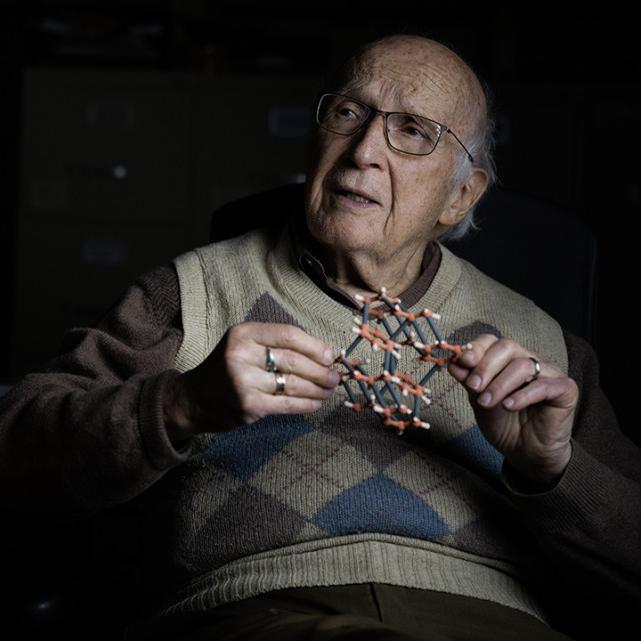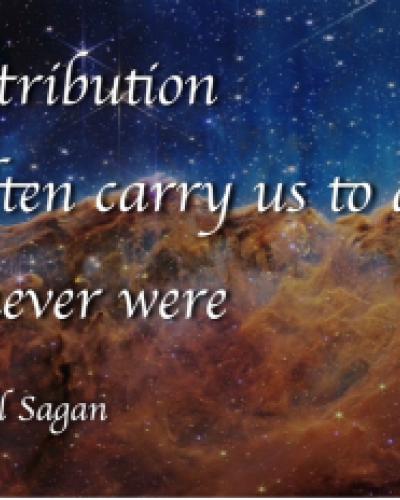If you search for the quote that NASA Administrator Bill Nelson used to conclude the recent JWST livestream—“Somewhere, something incredible is waiting to be known”—you’ll find a barrage of these words against spiraling galaxies and long-exposed skies, with the occasional image of Carl Sagan himself, floating happily amongst the stars. I’ve seen it in giant typeface on the wall of the Cornell University store, and on a T-shirt at the Hayden Planetarium. It has a lovely, but very easily Pinterest-able sentiment.
Shame he never said it.
I can’t claim to have read every piece of Sagan’s published writing in existence. But most of the time, if you look through enough sites with his quotes (or consult Wikiquote), you can find an exact citation and page number, pointing towards a source you can check yourself. For this particular phrase, there has never been a page number, and a scroll through Wikiquote finds it right at the top of the “misattributed” section.
Thousands of people have used this phrase. It’s even one of the first results when you Google “Carl Sagan quotes.” So let’s entertain the idea for a moment—how can anyone prove he never said it? Technically, there are billions of spoken words every day that never get written down. We still said them, even without the evidence, right? That’s true, but also not how science works. You can’t make a solid claim without evidence, or else it’s no more than a hypothesis.
In his book The Demon-Haunted World, Sagan describes a few tools for sniffing out the truth with a “Baloney Detection Kit” (Chapter 12). Relevant to our case: Occam’s Razor, or the idea that when faced with two hypotheses, choose the simpler one. Which makes more sense? That Carl Sagan said something that thousands of people don’t have a source for, or that he never said it at all?
Fortunately, there’s at least one piece of damning evidence showing reporter Sharon Begley wrote these words, not Sagan, as a closing sentence in an article about him. Without the microfilm copy of the Newsweek article, I can’t show you the smoking gun myself. Carl Sagan’s baloney detection tools state that whenever possible, there must be an independent confirmation of the facts; I can’t independently confirm the Newsweek article, but no other site has offered a more convincing source. Truly, no other sites offer any source at all.
In this case, the simplest assumption is that Carl Sagan did not, in fact, produce the phrase “Somewhere, something incredible is waiting to be known.” In no way do I mean to attack Bill Nelson or anyone preparing the statements at NASA. All of us get facts wrong once in a while, and it takes some close attention to suspect that this quote might be misattributed.
What can we do in the future? Even if you’re not a government official or a trusted organization with tons of research time to spare, it’s a good idea to check for a listed source on a quote before you use it—a book, article, or quick link. Without checking the book yourself, it’s still more likely to be legitimate than a source-less quote.
An inspirational sentence misattributed here and there on your Instagram probably isn’t your biggest concern. But it goes to show how easily false information can be consumed and spread. This is especially true when people tend to trust the word of government officials (Sagan warns against blind trust of authority in the Baloney Detection Kit).
One misquotation this time was largely harmless. The same cannot be said for scientific facts and public safety information. We live in an age where the truth is more important than ever. Carl Sagan’s detection kit, too, is more important than ever, and the tools at the heart of science itself. JWST’s stunning images remind us of the strength of this science, the immensity of our universe. Bill Nelson was right—many years of incredible insight await.
And as for me, many emails to Cornell University and the Hayden Planetarium gift shop await, so I might as well get working.
Gillis Lowry '24 is an undergraduate fellow of the Carl Sagan Institute at Cornell University. She is completing her major in Astronomy and her minor in Science Communication and Public Engagement. She is the Outreach Coordinator for the Cornell Astronomical Society as well as Publicity Lead for Cornell’s Alpha CubeSat. She shares a birthday with the late astrophysicist Carl Sagan, and hopes to inspire a similar passion for the universe.





